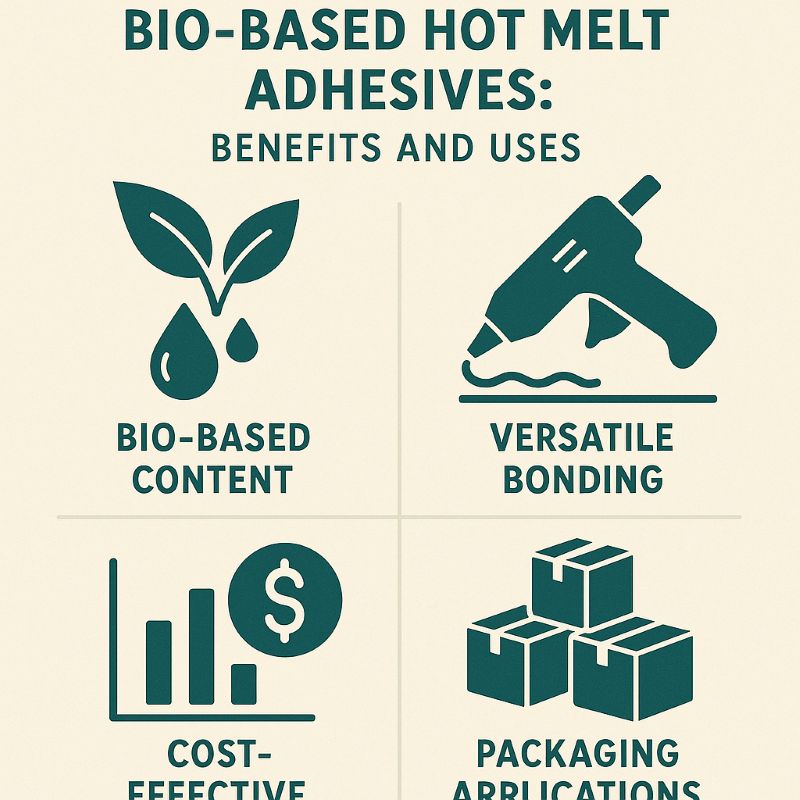
Understanding Bio-Based Adhesives
Types of Hot Melt Adhesives
Benefits of Bio-Based Adhesives
Applications in Various Industries
Methods of Adhesive Application
Latest Trends in Adhesive Technology
Sustainable Adhesive Strategies
Frequently Asked Questions (FAQ)
Bio-based adhesives are emerging as environmentally friendly alternatives to traditional petrochemical-based products. These adhesives are derived from renewable resources such as plant materials, agricultural byproducts, and natural polymers. Their sustainability is complemented by their ability to provide strong bonding performance. In hot melt applications, these adhesives are used widely across packaging, woodworking, textiles, and more—demonstrating a shift towards greener industrial practices.
Hot melt adhesives come in various types to accommodate different industrial needs. In the bio-based category, formulations made from renewable materials offer similar performance to traditional adhesives while supporting sustainability. For example, certain types are designed for woodworking and offer strong adhesion with minimal waste, while others are tailored for packaging applications that require durable seals. The diversity in these adhesive types highlights the ability of sustainable technology to meet practical and environmental demands.
Bio-based hot melt adhesives provide several advantages for companies aiming to reduce their environmental footprint. These adhesives are produced from renewable inputs, which help lower greenhouse gas emissions and reduce dependency on fossil fuels. They also offer bonding strength on par with conventional adhesives, making them suitable for demanding applications. Furthermore, their compatibility with modern production systems ensures smooth adoption without compromising productivity or quality.
The application of bio-based hot melt adhesives spans a wide array of industries. In the packaging sector, they are utilized for secure sealing while reducing environmental harm. The woodworking industry benefits from their reliable performance and clean application. In textile manufacturing, they enable durable yet flexible bonding, preserving material integrity. Automotive interiors have also begun to incorporate bio-based adhesives for their reduced emissions and sustainability credentials. These widespread applications underscore the adaptability and eco-efficiency of bio-based bonding technologies.
Application methods play a critical role in the effectiveness of bio-based hot melt adhesives. Techniques include slot die coating for uniform application, spray systems for broad coverage, and extrusion for high-speed bonding processes. Each method offers distinct benefits depending on the industry. Slot die is often preferred in precision packaging, spray techniques are common in textiles, and extrusion suits woodworking or structural assemblies. Choosing the right method enhances operational efficiency while supporting sustainable production practices.
Adhesive technology is evolving rapidly, with a growing emphasis on eco-conscious development. One of the most significant trends is the innovation of bio-based hot melt adhesives that balance environmental responsibility with high performance. These new formulations are being engineered to reduce VOCs, support biodegradability, and align with circular economy principles. As regulations tighten and consumer awareness increases, industries are investing more in sustainable bonding solutions to future-proof their operations.
To align with global sustainability goals, industries are adopting adhesive strategies that prioritize environmental responsibility. Bio-based hot melt adhesives, when used thoughtfully, can reduce waste, lower emissions, and improve the overall ecological impact of manufacturing. Whether in packaging, woodworking, or textile sectors, these strategies involve replacing petrochemical adhesives with renewable alternatives, optimizing application efficiency, and ensuring compliance with green manufacturing standards. Such approaches not only meet regulatory requirements but also enhance brand reputation among eco-conscious consumers.
What are bio-based adhesives?
They are adhesives made from renewable resources like plants or agricultural waste, offering an eco-friendly alternative to petrochemical-based products.
What types of hot melt adhesives are available?
Hot melt adhesives vary based on application—some are optimized for woodworking, others for packaging or textiles. Bio-based versions offer sustainable alternatives across these categories.
What are the main benefits of using bio-based adhesives?
They help reduce carbon footprint, decrease reliance on fossil fuels, and provide strong bonding suitable for industrial use.
Which industries use bio-based adhesives?
Packaging, woodworking, textiles, and automotive sectors all employ bio-based adhesives due to their performance and environmental advantages.
How are these adhesives applied?
Common methods include slot die, spray, and extrusion. Each method is selected based on precision, speed, or coverage needs.
What’s trending in adhesive technology?
The industry is focusing on sustainable innovation—especially on biodegradable, low-VOC, and renewable material-based adhesives.
How do sustainable adhesive strategies benefit companies?
They reduce environmental impact, meet eco-labeling criteria, and appeal to environmentally conscious customers.
Why switch to bio-based adhesives?
Switching supports long-term sustainability goals, ensures regulatory compliance, and aligns with the growing demand for greener materials.